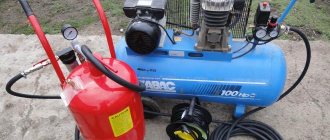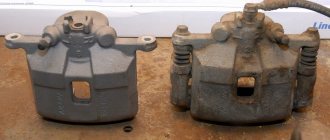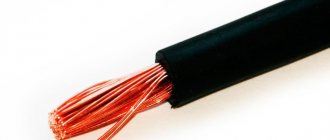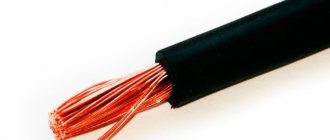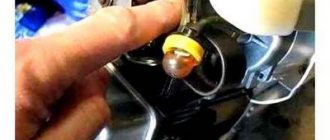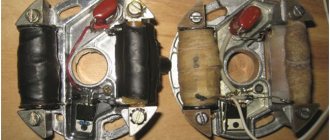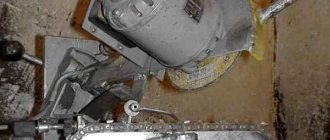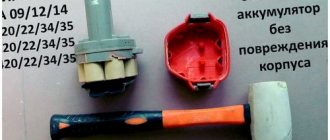Abrasive particles fly through the nozzle of sandblasting machines under high pressure to clean the surfaces being treated. The abrasive actively acts on foreign substances that need to be removed. Also, this working flow is aggressive to the inner diameter of the nozzle.
Therefore, nozzles are consumables and must be replaced regularly. For industrial installations, replacement nozzles can be purchased through service. But today there are homemade and factory-made installations for small workshops. For them, many craftsmen make nozzles themselves from used spark plugs of gasoline internal combustion engines.
sandblast gun resuscitation
Thanks for the information, it's spot on.
Great! I can’t get around to picking up a sandblaster myself. Either I’m afraid of this very wear and tear, or I simply have nothing to grab onto. We have YATO for sale, it seems like the company is not completely crappy, but the nozzles there are somehow not very comfortable. In terms of what will have to be changed, and where to get spare ones? Sharpening them is not very convenient. And there are some inexpensive pistols that I don’t really like. But the nozzles are simple, it makes you laugh. So I won’t buy it at all.
But does such a “candle” nozzle last long? Or even eternal?
just about a month ago I threw about 10 old spark plugs out of the car... in principle, everything is clear, I will try, especially since the need for sandblasting arises from time to time... THANK YOU!
Originally posted by TOPIC Minsk:
But does such a “candle” nozzle last long? Or even eternal? [/QUOTEIf you are not going to clean five squares a day, then consider it eternal))))))
no, the gun is not homemade, slightly modified, destroyed by sandblasting.
By the way, it is certainly possible to use ceramic nozzles for argon welding as nozzles. They come in different sizes (I have seen hole diameters of 4,5,6,7,8mm). cost around 25-30 rupees. not a shortage.
The insulator uses aluminum carbide (if I’m not mistaken), which is resistant to abrasion, which is why I use them, but for welding I don’t know what kind of material it is. And the external diameter of the candle is suitable. But as an option, there is no need to exclude welding. Try it and tell me
so there's nothing to tell. I don’t have such a pistol. I just recently bought these nozzles for a welder and they stuck in my memory. They will be some kind of pinkish-red color. They are quite fragile, because when the splashes of metal are removed, they break easily. very heat resistant.
Making a sandblasting chamber
Before proceeding directly to the assembly, it is necessary to take into account a number of factors: draw up a competent drawing and description (one of the options will be presented below), select all the necessary components and decide on the location.
You always want your own sandblasting chamber to be as large as possible, but this will entail a number of consequences: you need a more powerful hood, as well as more durable materials for the body.
The sandblasting chamber is a metal box containing:
- holes for gloves;
- observation window;
- holes for supplying a hose for a gun;
- ventilation holes;
- viewing window;
- bottom grid on which the workpiece will lie;
- hopper for collecting waste abrasive and debris.
Assembly order
The sandblasting chamber assembly procedure includes several stages
It is important to follow their sequence, otherwise it may create some inconvenience and delay assembly. The material you will need is a corner with a shelf of 25-32 mm, galvanized steel 0.5 mm thick, impact-resistant plastic, rivets
The manufacturing procedure is as follows:
- We cut the corners according to the previously prepared drawing.
- Using welding, we assemble a frame from them.
- We attach a reinforced mesh as a bottom, on which the workpiece will be located. The mesh must be strong to support heavy products.
- We light from the two upper corners so that there are no shadows. This will allow you to work with greater comfort. The lighting should be bright enough, as there will be a lot of dust inside. It is worth remembering a little trick: if you choose white light, for example, neon lamps, with this spectrum the view will significantly deteriorate. It is better to use yellow, for example, incandescent lamps, or LED lamps with a suitable spectrum. The principle is the same as in fog lights, thanks to which you can distinguish something in bad weather.
- We place pre-cut sheets of metal on the sealant. It is necessary that one of the walls can be opened for inserting and removing parts and servicing the chamber from the inside.
- Additionally, we fasten the metal to the corners with rivets.
- Using scissors, we cut out the necessary hole in the metal for the ventilation mittens.
- For safety reasons, it is better to make the viewing glass from impact-resistant plastic rather than glass, since it is possible that abrasives (not only sand, but also metal balls) will be used in the chamber.
- The chamber must be equipped with a powerful hood (the more powerful, the better, at least 1500 liters per minute).
Safety precautions
Using a sandblasting chamber, like sandblasting without it, requires compliance with the same safety measures
It is important to wear safety glasses, and in the case of a sandblasting chamber, only a respirator is sufficient. A fully covered suit and closed shoes are required.
It is also important to remember the safety of others. It is advisable that the camera be installed in a separate room where no one will be present.
We saw that making sandblasting with your own hands is not so difficult. It is enough to have certain skills and a great desire. Thanks to such efforts, you can save a lot of money and make a worthy analogue of the factory options.
A sandblasting chamber will be an excellent assistant and addition to your device, since thanks to it, performing assigned tasks will become less harmful to health, more comfortable and, accordingly, productive.
Operating principles
Lada Largus we replace spark plugs in a 16-valve engine.
Largus spark plugs The sandblasting nozzle is attached to a holder - the end of the hose, with a union nut or clamp. The air flow, passing through the container with sand, captures it and delivers it through the hose to the nozzle. Passing through the nozzle, the mixture is evened out in its composition and increases speed. Coming out of the diffuser, sand particles hit the surface of the part at high speed, knocking out particles of dirt and old finishes.
When installing Chinese nozzles, you need to pay attention to the diameter and method of attachment. They mostly have clamps on them.
They are mainly suitable for equipment manufactured in the Middle Kingdom. On devices from other manufacturers, the nozzle is installed through an adapter.
The homemade device is short-lived. It can be used at pressures less than 6 atm. Ceramic inserts are made from candles by drilling out the electrode. Cast iron and steel are drilled. The surface of the hole is rough, sand slows down and at the same time wears out quickly.
In sandblasting equipment, in addition to sand, other abrasive elements are used: crushed glass, metal balls, ceramics.
A nozzle you make yourself will not last long. It will help out when repairing your own car or restoring furniture.
How to operate compressors in winter?
When operating the unit in winter, it must be remembered that condensation forms in the pipelines. If it is not removed regularly, it may freeze. Therefore, industrial enterprises establish regulations for the maintenance of compressor stations. The water-oil condensate is drained every day before starting work. For powerful devices, up to 20...35 liters of such a mixture are collected in 8...16 hours of operation.
If a high-pressure gas line is laid across the territory of a workshop (building or building), then dryers are installed on it near the receivers. They also accumulate condensation during the winter. The cause of condensation is contact with cold walls. When there is no air flow through the pipe, drops of moisture occur. The water vapor present in ordinary air condenses.
For sandblasting installations, the presence of moisture in the system is unacceptable. The abrasive material gets wet. Traces of oxidation remain on steel surfaces. The equipment is damaged.
Attention! When operating abrasive cleaning units, an emergency pressure relief valve must be installed. Shut off the compressed air supply and open the safety valve
The air quickly leaves the receiver.
Features of choice
What to do if oil gets into spark plug wells
The main parameter for choosing a nozzle is the diameter of the nozzle hole. It depends on the operating mode of the sandblasting machine. The table shows approximate values of productivity and pressure depending on the diameter of the nozzle for a household sandblaster.
| Nozzle diameter, mm | Productivity, cubic meters m/hour | System pressure, atm | Sand consumption, kg/hour |
| 6 | 8–10 | 5 | 200–250 |
| 8 | 10–12 | 5–6 | 350–400 |
| 10 | 12–22 | 6–7 | 600–900 |
| 12 | more than 20 | 7–8 | 1000–1200 |
Industrial installations use nozzles larger than 12 mm.
The life of the nozzle depends on the material of the insert. An attachment made from a spark plug will last no more than an hour. This is enough for repair work in the garage. The service life of the steel nozzle is within 2 hours of continuous operation. Hard ceramics are destroyed during installation startup due to dynamic impact and uneven load. In addition to strength, the nozzle material requires high viscosity and abrasion resistance.
Nozzle inserts are made from different materials:
- high alloy steels;
- cast iron;
- ceramics;
- tungsten and boron carbide.
The cast iron insert can work up to 12 hours. Industrially produced tungsten carbide bits are suitable for use in workshops. Their service life depends on productivity and pressure, averaging 350 hours.
The most durable fluorine carbide inserts, capable of operating up to 1000 hours. At maximum loads, the nozzle can withstand 750 hours.
Industrial sandblasting machine
Recommendations from experts
Most of the problems that arise are related to improper assembly of the installation. Experienced craftsmen advise including air recirculation devices in the system, which seriously increases the productivity of sandblasting. Also, the quality of the finished device will be improved by a correctly selected nozzle. Tungsten nozzles are ideal because they have a long service life.
As for the compressor, you can take any device lying around in the garage, but more powerful units will increase efficiency. A homemade compressor will save money and make various jobs easy and affordable, reducing time costs.
Manufacturers
Toyota Sera 1.5 turbo 4WD Serafima Logbook MythBusters FHE connecting rods
Experts recommend nozzles from the following companies:
- Contracor - Russia;
- CLEMCO - Germany;
- VMZ - Velikoluksky Mechanical Plant.
German products are known for their reliable performance and long service life. Nozzles from CLEMCO are considered the best. The company produces mainly ceramic and tungsten carbide inserts.
Sandblasting nozzles from the Russian company Contracor are not inferior to them in quality. The main products are boron carbide, tungsten and ceramic inserts are available.
VSW produces conventional nozzles at a budget price. Hobbyists can purchase a variety of attachments - metal, ceramic and cast iron for one-time repairs.
What will you need?
Craftsmen recommend making nozzles from imported Champion and Brix candles with a long internal insulator. It is difficult to remove the core from domestic candles. It has extensions and small anchors for a strong connection to the ceramic. Therefore, when trying to pull out the metal core, the insulator often pricks. Such a candle is more reliable for its main use, but is less suitable for alterations.
Materials
In addition to the candle, you will need cutting discs for an angle grinder (grinder): for metal and diamond for concrete for cutting ceramics.
Tools
How to choose a nozzle for a sandblaster
A nozzle with a Venturi profile allows you to increase the speed of movement of the sand-air mixture by 2.5...3 times compared to nozzles with a different internal hole configuration. A modern nozzle for a sandblasting machine with a Venturi profile is capable of ensuring the movement of particles at the outlet up to 700...720 km/h. At the same time, the cleaning performance at the same mixture flow rates and pressures increases approximately 2 times.
Approximately, the selection of nozzle parameters can be made according to the following criteria:
- In terms of performance. With the required installation productivity of up to 10...12 m3/h, the internal diameter of the nozzle does not exceed 8 mm, with 12...22 m3/h - 10 mm, with higher productivity values, the diameter of the internal channel should be 12 mm;
- According to the highest air pressure. If it does not exceed 5 at, then the channel diameter can be taken as 6...8 mm, at pressures up to 7 at - 8...10 mm, at higher pressures - 12 mm;
- Depending on the specific consumption of abrasive. If this parameter does not exceed 200...250 kg/h, then a nozzle with a diameter of 6 mm is suitable, at 350...400 kg/h - 8 mm, at 600...900 kg/h - 10 mm, in other cases - 12 mm.
These recommendations apply to nozzles with cylindrical internal holes. To recalculate the given data for a nozzle for a sandblasting machine with a Venturi profile, the data on processing productivity should be increased by 35...50%, on flow rate - by 60...75%, and on pressure - by 15...20%.
An important element of choice is the nozzle material. Conventional high-carbon steels with increased abrasive resistance (for example, steels of type 75 or 65G) are not suitable for these purposes, since when hardened to maximum hardness they are characterized by increased sensitivity to impact loads, which inevitably arise at the initial moment of feeding the abrasive mixture into the nozzle.
Ceramic compositions have even less durability. For example, when making a nozzle with your own hands, they often use a used spark plug from a car engine as a starting material, removing the metal casing from it. At the same time, they do not take into account that the ceramics in the spark plug design are designed to work with a gas flow in which there are no solid abrasive particles. Therefore, the durability of such hand-made ceramic nozzles does not exceed several hours.
More efficient is the option with carbide nozzles, which are made of tungsten carbide. The surface hardness of such products reaches 85...90 HRA, with a surface bending strength of up to 1400...1600 MPa. The disadvantage of such solutions is the high sensitivity of tungsten carbides to temperature. When the temperature rises to 80...100ºС (which is quite likely during long-term sandblasting), temperature cracks may appear on the surface of the nozzle. The durability of nozzles made of hard alloys reaches 750...800 hours.
The best option is to make a nozzle from boron carbide. With approximately the same hardness and strength, boron carbides are distinguished by their high resistance to temperature changes, therefore they retain their functionality at temperatures of 600...750ºС.
It is also interesting to compare prices for sandblasting nozzles. Industrial products made of boron carbide, depending on the length, profile and diameter of the internal hole, can be purchased for 1200...1600 rubles, and carbide nozzles - for 2500...7000 rubles.
Sandblasting: what types of nozzles are there?
An abrasive blasting nozzle is a device designed to create a directed air jet with abrasive. The main purpose of the abrasive blasting nozzle is to increase the flow rate of the abrasive-air mixture, forming a specific spray pattern and contact spot.
The length and shape of the internal channel of the nozzle, which determine the speed of the abrasive particles, are of great importance.
The optimal nozzle length is at least 10 times the diameter of the outlet and is usually in the range of 100-250 mm.
Selecting the right nozzle for a particular situation depends on a proper understanding of the different effects each type has on the cleaning behavior and cost of the job.
Materials from which nozzles are made
The choice of nozzle material determines its life, depending on the abrasive that is used, how often and how hard you work, and the working conditions. Nozzles are subject to very intense wear, which is influenced mainly by the material of the nozzle and abrasive, the speed of particle movement, and air pressure.
Removing spark plugs
WD40 will help you unscrew the spark plugs.
The spark plugs are dismantled with special spark plug wrenches for 14, 16, 18, 20, 22 millimeters. Some engines (usually 16-valve engines) require long spark plug wrenches because the spark plugs are located in deep spark plug wells. The spark plugs are unscrewed counterclockwise. Care must be taken not to drop anything unnecessary into the cylinder, otherwise trouble cannot be avoided. In general, it is better to cover the wells with a rag while cleaning the candles to avoid troubles.
During dismantling, it is a good idea to check the condition of the high-voltage wires. They should be soft and without cracks. Silicone wires have proven themselves to be the best. They are soft and do not tan in the cold.
The candles are tightened with a certain force. For a beginner, it is better to use a special torque wrench, tightening the spark plugs with the force regulated by the car manufacturer.
Causes and types of soot
A small amount of carbon deposits also forms during normal engine operation, but sometimes it forms abnormally quickly. There are several reasons for this:
- Incorrectly selected candles.
- Low quality fuel.
- High oil loss due to wear of the CPG.
- Fuel system malfunction.
- Rich air-fuel mixture.
- Incorrect ignition timing.
Types of deposits
By the appearance of soot, you can understand the reason for its formation. Black oily deposits indicate that oil has entered the combustion chamber. Dark brown soot indicates the fuel mixture is too rich. Whitish soot indicates a lean mixture. Red soot indicates the presence of tetraethyl lead in the fuel, a substance prohibited as an additive to modern motor gasoline. But, due to its low cost, it is often used by unscrupulous owners of gas stations to increase the octane number of fuel. The normal color of soot is considered to be light brown with a brick tint. Such deposits indicate that the engine is running on the correct fuel-air mixture. This mixture is called stoichiometric (the ratio of gasoline to air is 14:1 by weight). This mixture burns most completely, releasing less CO into the atmosphere, allows the engine to operate more economically and increases the life of the lambda probe and exhaust system.
Application areas of the nozzle
Due to the high power of the jet, using the Karcher nozzle you can process various surfaces:
- clean wood and concrete from plaster, old paint, varnishes, building mixtures;
- remove rust and scale from metal;
- clean various products before processing, applying protective and finishing coatings;
- get rid of stubborn stains;
- remove stains and drips of glue and polyurethane foam.
Do-it-yourself sandblasting gun, including
- Buy or make it yourself?
- How to assemble a sandblasting gun yourself?
- Types of factory-produced sandblasting guns
A sandblasting gun can be an extremely useful and necessary tool for any business car owner. It is used for high-quality cleaning of various surfaces from foreign elements. With its help, metal parts are degreased and cleaned, old paintwork is removed, and traces of corrosion are eliminated. This does not require any effort. Sandblasting a part is much easier than trying to clean the metal with sandpaper with your own hands.
Buy or make it yourself?
Sandblasting guns can be found in any specialized store, so purchasing them will not cause any difficulties. Another thing is that not everyone will like the price of such a device. After all, good equipment is quite expensive, and economy class models can be unreliable in operation. In this case, the main selection criterion should be the compliance of the device parameters with the goals set. If the task is not to use sandblasting in large-scale production, then for domestic use it is quite possible to make a gun with your own hands.
Homemade sandblasting guns are assembled from a variety of available materials. The main principle for selecting parts is their performance characteristics. After all, the high abrasiveness of the working substance and the high feed speed create a rather aggressive environment for the elements of the gun and contribute to the rapid wear of its parts. Conventional sandblasting, as a rule, produces pressure from 4 to 10 atmospheres!
The good news is that to assemble the device with your own hands, you do not need to have a higher technical education or understand complex circuits. The simplest sandblasting device includes:
- handle;
- two fittings;
- nozzle.
How to assemble a sandblasting gun yourself?
Craftsmen use all kinds of household items for assembly: tees, ceramic nozzles from a dental machine, valves from spray guns. However, it must be borne in mind that the less durable materials you use, the shorter the service life of the manufactured device. A ceramic nozzle is unlikely to withstand more than three to four hours of intensive work, since it is not adapted to high abrasive loads. It is better to use a nozzle made of carbide alloys with boron or tungsten. This measure will increase the operating time of a home-made device tenfold.
The body of the device is machined to fit the size of the nozzle. Fittings and a handle are attached to it. To simplify assembly, you can use water fittings, a tee and a plastic bottle as a container for sand. It is attached to the top of the device. Sand is poured into it, then a hose from a compressor with compressed air is connected to the gun.
Types of factory-produced sandblasting guns
The design of sandblasters can vary greatly depending on the manufacturer, as well as on the factors that determine the features of their functioning. For example, there are models adapted for different methods of forming an abrasive mixture: with air or with water. In addition, the design may provide for various methods of supplying abrasive.
In accordance with this, they distinguish:
- Devices with a special tank. This model resembles a regular spray gun. With its help it is convenient to process small surfaces. For example, removing carbon deposits from spark plugs or oil stains from metal parts.
- Devices with hoses. In this version, two hoses are connected to the gun. One of them supplies compressed air, the other - abrasive material. Due to the absence of a bulky tank, such a device is more compact and suitable for treating hard-to-reach places.
In any case, no matter what device you choose, it will certainly be able to find its application in your garage. Expensive factory models will be more reliable. If you don’t want to spend large amounts of money, then you can easily assemble the device yourself.
DIY Tricks
The sandblasting apparatus is technically simple in general, but due to the difficult working conditions - under considerable pressure, in an aggressive environment - its design and manufacture is a rather complex task. Do-it-yourselfers sometimes overcome the difficulties that arise in this case in rather ingenious ways. That's why they are craftsmen, after all.
Bunker from a cylinder
The consumption of abrasive for all types of sandblasting work, except artistic polishing, is very high. A household gas cylinder or, say, a car receiver, these are vessels of sufficiently large capacity, designed to work under pressure and are almost not subject to operational wear. It is easier to insert a simple tip with a nozzle into the sandblasting chamber, and it is easier to operate it with thick rubber gloves than with a gun. Therefore, many hobbyists make their own sandblasters with an abrasive hopper from a gas cylinder.
How to properly make sandblasting from a gas cylinder or plastic bottle
However, if you simply convert the cylinder into a sandblasting hopper in pressurized mode (item 1 in the figure), then an unpleasant phenomenon is immediately discovered in the work: the powder in the hopper is still half or a third full, and the installation begins to snort and spit clouds of dust instead of do your thing. The reason is the sucking of air through the abrasive in the hopper, pos. 2. You can avoid it by quickly adjusting the boost, but this is no longer a job, but a chore. Therefore, it is better not to be lazy right away, cut off the top of the cylinder (which will now be the bottom of the hopper) and instead weld on an abrasive sealing cone made of galvanized steel from 0.6 mm, pos. 3. There will be no suction even with a primitive mixer made from a straight water tee, pos. 3b.
The author’s find of a mini-sandblaster with a hopper made from a plastic bottle, pos. 4. Spiral ribs on the high neck of the bottle slightly, but they swirl the flow of sand even before it enters the mixer. This equally primitive sandblasting tool, based on what appears to be an inexpensive universal working pneumatic gun, is certainly suitable for very delicate work.
Sandblasting weapon
A sandblasting gun is convenient for cleaning large surfaces for painting, for example. bodies of used cars, so they are sold out well, and amateurs adapt paint or universal working pneumatic guns for sandblasting. Most often - according to the gravitational injection scheme; less often - according to the scheme with lower boost. Some people are not too lazy to make analogues of industrial designs, see, for example, video:
Industrial samples of high-quality sandblasting guns are made using a pneumatic ejection scheme - ejection sandblasting consumes a minimum of abrasive and, accordingly, least dusty. Instead of a hopper, the abrasive for them is poured into a plastic bag without the slightest holes. The intake device is a piece of rigid pipe tightly inserted into the supply end of the abrasive air hose. The neck of the bag with abrasive is tightly tied around the intake pipe - and atmospheric pressure helps ejection well, compressing the bag as the powder is consumed.
The range of factory-made sandblasting guns (on the left in the figure) on sale is quite wide. On Alibaba, etc. Sandblasting nozzles for working pneumatic guns are on sale in the center. If you choose, then for general work choose ejection ones as they are the safest and consume less abrasive per square of the surface being treated than others. For fine and artistic work, a gun or a nozzle with lower pressure is more suitable, see above, but these are more expensive.
Sandblasting gun, sandblasting nozzles for working pneumatic guns and a homemade ejection sandblasting nozzle from plumbing parts
The same Chinese are also selling sandblasting nozzles with standard plumbing threads. An ejection abrasive blasting nozzle for such a nozzle can be made from parts of a water supply system; joints must be sealed with FUM tape, on the right in Fig. This sandblaster will not last long, but it is suitable for occasional use over small areas.
However, in any case, do not forget - we are talking about your health in the distant and not so distant future. Therefore, work only on a site that is at least 150 m away from residential buildings, poultry and livestock farms, cultural plantings, water points, parks and forests. The nearest children's or sports facility, playground or sports ground or pond must be at least 500 meters away. m. The influence of abrasive dust depends not only on its type and concentration, but also on the time of exposure. If it does not exceed 2-3 hours a day in portions of 15-20 minutes with breaks of 5-10 minutes, then on the site it is possible to do without full ammunition, but lightweight equipment is still needed:
- A soft, supercharged helmet with a cape, or, better yet, a gas mask and a head cape with a gorget that protects the neck and shoulders, such as those used by builders and concrete workers;
- One-piece overalls made of dust-proof fabric or a robe made of trousers with a belt and a jacket with a hem with a tight elastic band;
- Cuffs of sleeves and trousers - with rubber cuffs with a width of 7 cm;
- Combat boots (must go with untucked trousers!).
Note: when working with sandblasting irregularly for no more than 20 minutes a day, you can use a helmet with a non-supercharged cape and a petal respirator to protect the respiratory system.
Cleaning candles at home
There are several ways to clean carbon from candles:
- Mechanical.
- Chemical.
- Ultrasonic.
- Combined.
How to remove carbon deposits from spark plugs mechanically
Spark plugs can be cleaned mechanically without any coatings of noble metals, such as iridium. For rough mechanical cleaning, a needle file and fine-grained sandpaper are suitable.
Burning candles on a gas burner
If the spark plugs are heavily soiled, they can be preheated on a gas burner until the thick oily carbon burns out.
Care should be taken not to overheat the spark plug insulator; allow it to cool in air to avoid cracking of the insulator
Some candles cannot be ignited. This will lead to their failure.
Large deposits on the skirt and electrode must first be cleaned with a needle file. Then sand with sandpaper until shiny. Mechanical cleaning can also be done using a solvent. White spirit will do. A hard brush or toothbrush is moistened with solvent. Then, carbon deposits are removed from the electrodes using circular movements. An iron brush used by welders in their work is also suitable for mechanical cleaning of carbon deposits. After cleaning the spark plugs mechanically, the recommended gap should be restored by bending the side electrode. The gap can also increase due to natural burnout of the electrode material during operation of the internal combustion engine.
Video: mechanical cleaning of candles with sand at home
How to clean spark plugs chemically: instructions
Dry cleaning
The chemical method is suitable for candles whose electrodes are coated with noble metals. For chemical cleaning of simple or iridium candles at home, household products for cleaning limescale and rust from sinks and bathtubs are perfect. Ordinary acetic acid, available in every home, is also a good remedy. It is better to use a 70% solution. Can be diluted with water one to two for safety when working. The cleaning liquid is poured into a glass or plastic container of a suitable size. The candles are immersed in the cleaning solution up to the level of the nut and left for several hours. It is advisable to change the cleaning fluid once or twice. All carbon deposits will precipitate at the bottom of the container. After this, you should remove the candles and dry them with a hairdryer or in the open air, if there is enough time. You can place candles on radiators or radiators of the heating system. After drying, check the gap between the electrodes and screw the spark plugs into place.
Video: several ways to clean candles with chemicals
Cleaning spark plugs with ultrasound
Ultrasonic bath
The ultrasonic method is used extremely rarely, but is not inferior in efficiency to the chemical method. This method requires an ultrasonic bath, which not every car enthusiast has. If such a bath is available, then first the spark plugs are cleaned of large carbon deposits and then immersed in an ultrasonic bath. 40–50 minutes is enough. After this, the candles must go through a drying process.
Combined method
This method involves first rough mechanical cleaning and then chemical or ultrasonic cleaning.
Cleaning result
After cleaning the spark plugs from carbon, the effect can be easily felt as soon as you start the engine. The operation of the motor should become smooth and stable. Fuel consumption with spark plugs cleared of soot will decrease by several percent. Engine dynamics and response will noticeably improve. Detonation and glow ignition will disappear, which means that the life of the internal combustion engine will be longer.
It is not necessary to spend money on buying new spark plugs when it is time to replace them. Most often, simply cleaning them from carbon deposits is enough. This will save a decent amount of money, since a set of new high-quality spark plugs is not cheap, and if we are talking about a six or eight-cylinder internal combustion engine, then even more expensive.
Feasibility of the operation
This method of producing a sandblasting machine has advantages, but is also not without disadvantages. Among the advantages are big savings thanks to “emergency reserves” and getting a full-fledged sandblasting machine for personal use. The power of the device is important, since a homemade device is often more productive than factory designs. At least budget models.
There are also disadvantages that need to be assessed:
- not every household has a powerful “overloading” compressor, and its purchase will cost a hefty sum, so you will have to forget about saving with a capital “S”;
- Not all home craftsmen know how to use a welding machine; sometimes a drilling machine or lathe is required;
- low-quality components - a guarantee of rapid failure of the product;
- The slightest mistake or omission during assembly can lead to injury.
Do-it-yourself sandblasting cannot be considered an adventure, but before you get down to business thoroughly, it is better to soberly calculate the strengths, capabilities and likely consequences.
Advantages and disadvantages
Sandblasting equipment allows you to quickly clean the surface of various contaminants and outdated finishes:
- dirt;
- oil;
- scale;
- fat;
- dye;
- primer;
- putty.
It takes several times less time to prepare a part for further processing and painting than using detergents and solvents.
Sand is easy to obtain. If used continuously, it can be used several times. It must be sifted and calcined.
The air flow with sand and other abrasives penetrates narrow cracks and small holes. The cleaning speed does not depend on the complexity of the design.
Sandblasting machines have a simple design. It is enough to connect the compressor and a container with sand with hoses.
Disadvantages include operating equipment under high pressure. If a hose ruptures or enters the work area, a person may be seriously injured.
The attachments wear out quickly. A metal nozzle made of abrasion-resistant steel is enough for 1 – 2 hours of operation.
Compressor performance
The diameter of the nozzle, first of all, depends on the performance of the compressor (the number of cubic meters of compressed air per minute): the more productive the compressor, the larger the diameter of the nozzle can be used effectively (see table below). The most interesting thing: the higher the compressor performance, the less abrasive consumption will be for cleaning each square meter of the surface being treated.
If you use a nozzle that is less than optimal, there will be a loss of performance and the nozzle may become clogged more often.
If the nozzle is larger than optimal, there will be a loss of kinetic energy of the abrasive-air mixture, which also entails a drop in work productivity with a simultaneous overconsumption of abrasive material.
The pressure created by the compressor is not a determining factor and will be an important parameter if the work site is located far from the compressor, or is located much higher in level than the compressor.
Floor version of sandblasting
In order to build this simple device, you should acquire the following materials:
- old water heating 15-liter boiler;
- a spark plug, from which the injector will subsequently be made;
- a plug from an old cast-iron battery, the thread of which matches the diameter of the water pipe cut from the boiler. It does not need to be cut off completely; 7-10 cm should be left. A small piece of reinforcement is welded horizontally to the plug, which will serve as a handle for ease of use;
- for tightness, a small gasket cut from a piece of rubber is put on the plug from the plug;
- You will also need hoses to drive to the compressor and return excess air.
Important! Sand will be poured into the installation through a pipe with a plug into the apparatus.
A half-inch tube is welded in the center to the bottom of the tank, a thread is cut at its end and a ball butterfly valve is subsequently screwed on. A regular tee is attached to it. In this case, the outlet pipe is not cut; in general, the boiler tank does not change, since the hot water outlet pipe reaches the very top of the inside of the structure.
A fitting is connected to the outlet pipe, from one end of it the hose will go to the air supply tee, and the compressor hose will subsequently be connected to the other edge. As a result, the air supply is regulated by the tap, on which the intensity of the sand jet output will depend.
To make it easier to move the sandblasting machine, a pipe with a handle is vertically welded to it, and in the lower part there is a cross with small wheels. They can be removed from a wheelbarrow or baby stroller.
In this case, the candle will not be inserted into the cuff. Instead, the sand will come out through a nozzle designed based on the same butterfly valve, a plug for it and a ceramic element from a spark plug.
If all structural elements have reliable connections, such a device will last a long period, and most importantly, it will cost the owner several times less than a factory installation.
- Which is better Navitel or Yandex Navigator
- Do-it-yourself sandblasting machine: diagrams and drawings
- How to make a homemade compressor for sandblasting
- Land Cruiser 200 diesel: tax, comparison with the gasoline version, replacing the fuel filter
Manufacturing method from a spray gun
Sandblasting can also be done using a spray gun. For assembly you need to prepare:
- a gun that functions as a mixing valve;
- handle with air supply device;
- a plastic bottle that acts as a tank for abrasive;
- tee;
- ball valve for regulating sand supply.
Using an airbrush instead of a spray gun will allow you to apply abrasive at higher pressure due to the smaller thickness of the outlet channel.
Assembly is performed in the following sequence:
- The gun is bored to increase the diameter of the output nozzle.
- The mixing tee is attached to the gun.
- The supply and circulation hoses are installed and attached.
Design and characteristics
The purpose of the nozzle is to increase the speed of air flow with sand and form a treatment spot. The straight nozzle has the main elements:
- frame;
- thread for fastening to the nozzle holder;
- confuser;
- diffuser.
The housing protects a person from injury in the event of destruction of the internal nozzle. It is quickly erased by abrasive particles passing through it. At the same time, on the back of it there is a thread for a union nut or clamp, with which it is attached to the handle - the nozzle holder.
The confuser is a long conical hole in the insert that regulates the speed of the supplied mixture. Has standard holes with a diameter of 6–16 mm, with a pitch of 2 mm. The choice depends on the performance of the installation.
The diffuser is conical, short, expands at an angle of 7–15⁰. Thanks to it, turbulence is eliminated and the sand is evenly distributed over the working spot. The outlet of the nozzle can be round or oblong, depending on the size of the workpiece and its shape.
Between the confuser and the diffuser there is a section with a uniform cross-section. Having passed along the tapering cone of the nozzle, air and sand form a mixture of uniform composition.
Venturi nozzle
The complex design of the high-performance Venturi nozzle has an internal diameter with a stepped variable cross-section, consisting of a number of cylinders. The diameter of the inlet hole is almost 2 times larger than the outlet hole. This changes the nozzle parameters and increases the flow rate when operating in one mode. For example, an air-sand mixture comes out of a classic nozzle at approximately 320–350 km/h. When installing a Benturi nozzle, the speed of the outflow flow increases to 700 km/h.
The nozzle has a complex design. In addition to the standard elements, the tip is protected by a shockproof rubber shell. There is an aluminum bushing underneath for strength. Insert made of durable and abrasion-resistant tungsten carbide alloy.
Sandblasting with a Venturi nozzle
Design and operating principle of sandblasting
The operating principle of any sandblasting installation is based on the impact of abrasive particles on the surface being treated. Depending on the working mixture used, the mechanical force created can vary from extremely weak to intense impact.
There are a variety of categories of sandblasting equipment. This could be a classification:
- along the flow carrying the abrasive: flame, air or liquid;
- depending on the abrasive with which the sandblaster works (plastic granules, glass balls, steel shot, powder abrasives and much more);
- according to the engineering solution: ejector and pressure.
In general, the design of a sandblasting machine is quite simple. It contains a flow generator (air, liquid, flammable agent), a container with a working mixture, an exhaust duct and a gun, and an operator’s tool. Additional equipment includes a receiver, automatic control and regulation, emergency response mechanics, connecting and power cables. However, depending on the specific engineering solution, the main principles of the structure may differ from each other.
Pressure plant
Pressure sandblasting is the simplest. It is based on a container with abrasive. Under air pressure (for simplicity, only such units will be considered):
- the abrasive is mixed in the storage hopper and enters the receiving chamber in a uniformly dispersed state;
- the working mixture is captured by the air flow and flows through the outlet hose to the gun.
The pressure plant layout is simple. This ensures not only reliability and fault tolerance of the equipment, but also high productivity in combination with a wide range of abrasives available for use.
Ejector installation
In an ejector installation, the capture of the abrasive mixture occurs as a result of the formation of low pressure in the intake area. The scheme works as follows:
- compressed air enters directly into the gun;
- the sprayer type design creates a low pressure in the intake tube as a result of the Bernoulli effect;
- The abrasive mixture in the area of the air intake tube into the container is sucked into the outlet hose and enters the gun.
The characteristics of the gun outlet hose and nozzle play an important role in the parameters of the surface treatment process. This statement is true for any type of equipment. By increasing the diameter of the hose, a larger amount of working mixture can be supplied. To pass it through you will need a nozzle of significant diameter. However, this will reduce the particle speed and, consequently, the speed and intensity of treatment of the target surface. Therefore, in practice it is necessary to carefully balance the ratio of the diameters of the nozzle and the supply hose to achieve optimal results.
Naturally, sandblasting installations differ in weight, size and productivity. For example, low-power ones are compact and used in small workshops. To transport medium-sized vehicles, wheeled vehicles are used; such sandblasting machines will be required for processing the walls of buildings or metal structures. The most powerful class of equipment is usually used permanently, for multiple operators in an industrial environment.
The basic operating principle of a sandblasting machine for cleaning spark plugs
The sandblasting machine is designed for cleaning all types of spark plugs, so purchasing it or making it yourself pays for itself quite quickly. It is easy to operate and does not require significant energy consumption. The device operates from an external air supply source, that is, a compressor. The device is connected to the compressed air line via a fitting.
Dry quartz sand or sifted river sand is used as a consumable; if this is a floor installation, then the candle is inserted into a rubber cuff. But you can build a simpler device, the basis of which is an air pistol.
Overview of species
Types of functional devices can be divided into:
- pressure (designed for a large area that needs to be treated);
- injection (ideal for non-industrial work).
In turn, injection systems are divided into:
- suction;
- vacuum (the abrasive does not remain on the surface, but is sucked back by the vacuum);
- pneumatic – optimal for carrying out work over a large area.
The nozzle for a sandblasting machine can be:
- different diameters (both outlet and in the holes on the nozzle);
- round or oval cross-section;
- made of different materials - ceramic, steel and cast iron, boron carbide, fluorine (up to 1 thousand hours of operation) or tungsten.
In the description, you should definitely look at the performance of the compressor (this is one of the factors in the correct selection of the tip).
The Venturi nozzle stands separately, it has a complex design and is not cheap, but if the direct-flow nozzle gives an abrasive flow rate of no more than 340 km, it provides an indicator almost twice as high. When creating it, the principle of the Laval nozzle was taken into account, which in many cases determines the optimization of operation and regulation of the direction of the emitted jet.
